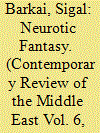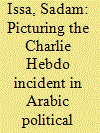|
|
|
Sort Order |
|
|
|
Items / Page
|
|
|
|
|
|
|
| Srl | Item |
| 1 |
ID:
178952


|
|
|
| 2 |
ID:
169976


|
|
|
|
|
| Summary/Abstract |
In the political reality of Israel, some symbols lie at the heart of the political, religious, national, and historical discourse that characterize the peoples and cultures living on the Israeli-Palestinian soil. Among these, the Temple Mount in Jerusalem is one of the most complex and conflictual symbols. The multiple religious claims to the Temple Mount—Jewish, Christian, and Muslim—are the subject of extensive study, but this article focuses on their reflection in contemporary Israeli art. In traditional Jewish art, the visual representations of the Temple or of Jews praying nearby expressed the longing of the Jews for generations to return to the Mount. In contrast, Yael Bartana and Nira Pereg view the multiple socio-political currents and religious rituals surrounding the Temple Mount as a reflection of the internal public debate regarding the face of the Israeli society today. This article discusses the contribution of their visual art to a conscious and aware discourse about the Israeli society and the underground currents that shape its contemporary identity. The analysis of their work tracks a “politics of aesthetics”—interpretation of the images within a socio-political context—and draws upon Israeli sociology, art history, and visual culture. In-depth personal interviews with the artists also inform the analysis.
|
|
|
|
|
|
|
|
|
|
|
|
|
|
|
|
| 3 |
ID:
147388


|
|
|
|
|
| Summary/Abstract |
This article investigates how the Arabic political cartoons picture the mocking cartoons of the Prophet Muhammad by the French satirical Charlie Hebdo magazine.1 It is noticed that the cartoons utilize the Charlie Hebdo incident as a locus to deconstruct the unjustness and bias of the Arabic leadership and the international community in their dealing with some Arabic political issues. The surveyed cartoons also used the Charlie Hebdo incident as a locus to formulate the Palestinian “imagined community” (Anderson, 1991). I argue that the surveyed cartoons use the strategy of “differentiation” (Meyer, 2000) based on the self vs. other dichotomy to establish this deconstruction and imagined community. The study uses the semio-linguistic and visual rhetorical tools (Barthes, 1972), and self-categorization (Turner, 1987) to achieve this deconstruction, through an analysis of semiotic-discursive aspects of a small corpus of Arabic political cartoons. The findings indicate that promoting a discourse of fear and danger toward the inside and outside actors is what constitutes this self-other-based identity.
|
|
|
|
|
|
|
|
|
|
|
|
|
|
|
|
| 4 |
ID:
090119


|
|
|
|
|
| Publication |
2009.
|
| Summary/Abstract |
During the 1980s and 1990s, a "dominant discourse" of internal migration developed in China, portraying the migrants' contribution to China's economic development while highlighting the social problems associated with rural-to-urban migration. In recent years one can trace a shift, evident in academic research, popular and media rhetoric, and policy formulation, toward a more migrant-centered narrative. This article aims to show that this change was in part the result of an emerging alternative discourse-initially created by a cultural avant-garde-representing a growing interest in migration and an ambivalent and even sympathetic view toward migrants, their social quandaries, impact on urban society, and opportunities for integration. In the examination of this alternative discourse, the article reviews contemporary visual representations of migration and the surrounding discussions (at public events, in scholarly works, and on the internet), which reveal the creation of a sociocultural "public sphere." By unearthing the alternative discourse, the dialectical connection between discourse and social change is brought to light, as these visual works not only reflected a complex reality but also contributed to remodeling it.
|
|
|
|
|
|
|
|
|
|
|
|
|
|
|
|
|
|
|
|
|